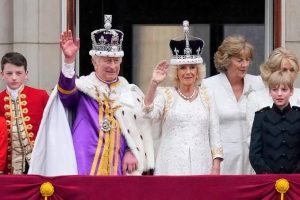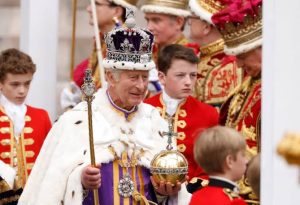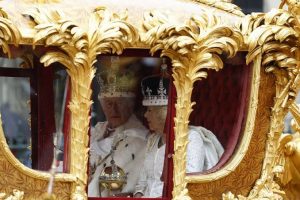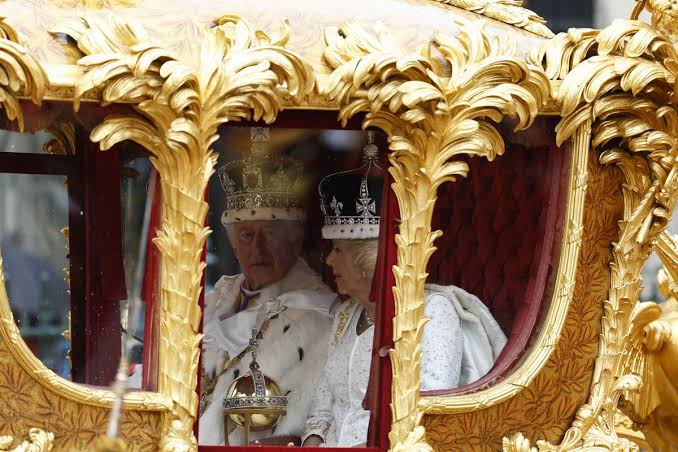
At exactly 18:30 on September 8, 2022, the sun set on the second great Elizabeth era. The world mourned the passing of Queen Elizabeth II, the longest-reigning British monarch. As the nation observed a period of mourning, preparations were made for her state funeral, which would mark the end of an era and the beginning of a new one.
The death of Queen Elizabeth II set in motion Operation London Bridge and Operation Unicorn, a collection of plans and protocols for her funeral and death occurring in Scotland. The United Kingdom entered a national mourning period of 10 days, and people from all walks of life queued up to pay their respects at Westminster Hall. The state funeral on September 19 was a grand event, watched by millions around the world. The magnitude of the security operation and the presence of dignitaries from across the globe made it a historic moment.
On that day the Queen breathed her last, as the sun rose, a new era unfurled its wings. The radiant aura of hope mingled with grief, for it was the day Prince Charles, the Prince of Wales, ascended to the pinnacle of power, donning the majestic mantle of King Charles III.
On the hallowed grounds of Westminster Abbey, the stage was set for an awe-inspiring spectacle. The grand coronation of Charles and his beloved wife, Camilla, unfolded on the momentous occasion of May 6, 2023. The air grew heavy with anticipation as the world witnessed this symbolic passing of the torch.
Within the hallowed walls, a cherished fusion of age-old customs and unwavering belief wove together, casting a spell of reverence upon all who bore witness. The ceremony, a profound religious rite, elevated Charles to his spiritual calling while acknowledging his weighty secular duties. The palpable air was pregnant with the weight of history, as the kingdom embraced its new sovereign, standing resolute in the face of an uncertain future.
Queen Consort Camilla was also crowned, and the new king received the coronation regalia, symbolizing his worldly and spiritual power. The world watched as a modern monarchy took shape, blending tradition and adaptability to meet the expectations of a contemporary society.
Symbol and Tradition
In the heart of the grand coronation ceremony of King Charles III, symbolism and tradition intertwined, creating a tapestry of awe-inspiring spectacle. Each element carried the weight of centuries, invoking the spirit of a storied lineage that stretched back through time.
The regal crown, encrusted with the most precious gems, glistened under the ceremonial lights, symbolizing the sovereign’s authority and responsibility. As it was placed upon King Charles III’s head, the weight of history settled upon his brow, a reminder of the weighty decisions he would make and the legacy he would leave.

The anointing oil, blessed by religious leaders, anointed the king’s hands and forehead, signifying his divine right to rule. The scent of the oil permeated the air, transporting all present to an ethereal realm where tradition and spirituality merged.
The coronation robe, meticulously embroidered with emblems of the realm, cascaded around the king’s shoulders, cloaking him in the regal splendor of his ancestors. With each step he took, the weight of tradition unfurled behind him, a vivid reminder of the unbroken chain connecting past, present, and future.
As the king knelt before the ancient altar, the sacred words of the oath echoed through the hallowed halls. His voice, firm and unwavering, pledged loyalty to the nation, to protect and uphold its values. It was a solemn vow a testament to the enduring commitment to service that defined the monarchy.
The symbols and traditions of the coronation ceremony captured the imagination of the world, drawing them into a realm of mystique and grandeur. They reminded us that even in a changing world, where the tides of time erode the old, there are pillars of tradition that stand strong, anchoring us to our collective history.
In this moment, as King Charles III ascended the throne, the weight of symbolism and tradition fused with the promise of a new era. It was a thrilling and captivating spectacle, a compelling testament to the enduring power of the monarchy and its ability to adapt while preserving the essence of its noble heritage.
Challenges Faced by the New Monarch
Several challenges awaited King Charles III as he embarked on his reign. The new king had to confront issues that would define his monarchy and shape its future. One of the primary challenges was ensuring the relevance of the monarchy in a rapidly changing world. King Charles III recognized the need to modernize the institution, focusing on the immediate line of succession and streamlining the royal family. He aimed to appeal to the younger generation, particularly Generation Z, who viewed the monarchy as emblematic of an unjust society.
But amidst the coronation celebrations, bubbling Republican sentiment became increasingly evident. Protesters took to the streets, voicing their discontent with the monarchy and advocating for an elected head of state. The possibility of abolishing the monarchy seemed more attainable than ever before, with support for its abolition rising significantly.
The challenges extended beyond the United Kingdom to the Commonwealth realms. Several Caribbean countries expressed their intent to remove King Charles as their sovereign, following the precedent set by Barbados. Calls for reparations and addressing the monarchy’s historical involvement in slavery grew louder. The king acknowledged these concerns and committed to supporting research into the monarchy’s connection with the slave trade.
Furthermore, King Charles III faced the pressing need to address systemic biases within the Royal Family. The conversations on racism sparked by recent incidents demanded a proactive response from the new king. He pledged to weed out biases, diversify staff, engage with anti-racism organizations, and promote inclusivity.
The departure of Prince Harry and Meghan from the Royal Family added to the challenges facing King Charles III. Repairing the strained relationship and addressing the internal conflicts within the family became imperative for the new king.
Another cloud looming over the monarchy was the presence of Prince Andrew, who faced backlash over his connection to Jeffrey Epstein. Stripped of his military titles and royal patronages, Prince Andrew’s scandal remained a challenge for King Charles III as he sought to address various issues and repair the reputation of the monarchy.
As King Charles III began his reign, expectations and potential changes in the role of the monarchy were discussed. While the new king acknowledged the need for change and expressed a commitment to respecting constitutional rules, the role of a constitutional monarchy
The Future of Monarchy

The future of the monarchy rests on King Charles III’s ability to maintain continuity and be a unifying force in a world that has always known Queen Elizabeth II. With her departure, the King faces the challenge of connecting with the national psyche and becoming a constant and reassuring presence in the country’s life. His coronation, which was diverse and included a role for non-Christian faiths, signaled a transition from a magical monarchy to a public service monarchy.
As King Charles III and Queen Camilla ascend the throne, they have the opportunity to reshape the monarchy and adapt it to the changing times while preserving its core values and traditions. They must act as ambassadors and figureheads, representing the diverse interests of the nation and fostering unity. To ensure the monarchy’s relevance and longevity, they must address pressing issues such as societal changes, environmental concerns, and the evolving expectations of the public.
The success of King Charles III and Queen Camilla in connecting with the people and embracing inclusivity will be crucial. The future of the monarchy hinges on their wisdom, empathy, and genuine commitment to serving the nation in these challenging times.
The coronation of King Charles III and Queen Camilla represents a pivotal moment in the monarchy’s history. We have explored the symbolic significance of the ceremony, delved into the rich traditions and grandeur that define it, and considered its implications for the monarchy’s future.
The coronation signifies a seamless transition of power and provides an opportunity for the new monarchs to shape the institution in accordance with the changing times. Their roles as ambassadors, advocates, and figureheads carry immense responsibility, requiring them to connect with the people and address pressing issues of our era.
As society evolves, the monarchy must adapt to remain relevant and effectively serve the nation. It is a call for King Charles III and Queen Camilla to embrace their roles with grace and authenticity, fostering unity and representing the diverse interests of the nation.
The future of the monarchy depends on their ability to navigate challenges, embrace change, and uphold the enduring values that have withstood the test of time. Let us observe their reign with curiosity and optimism, as the monarchy continues to evolve and contribute to the intricate tapestry of our cultural and historical heritage.











Leave a Reply